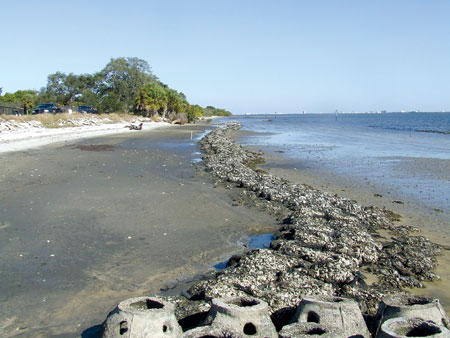
A newly constructed living shoreline along Audubon’s Alafia Bank Bird Sanctuary protects critical bird habitat from erosion in Hillsborough Bay.
According to NOAA, a living shoreline is defined as a “protected and stabilized shoreline that is made of natural materials such as plants, sand, or rock.”
Completed last year, the living shoreline stretches for more than a mile at the mouth of the Alafia River, parallel to shorelines covered in mangroves. The Alafia Bank is a Florida Fish and Wildlife Conservation Commission-designated Critical Wildlife Area (CWA) and a Globally Important Bird Area by BirdLife International. Audubon Florida manages it in collaboration with The Mosaic Company and Port Tampa Bay as a bird sanctuary.
Originally created with dredged material in the 1920s, erosion from ship wakes and storm events threatened this nesting site over the years. Audubon Florida has been working to devise a more resilient future by offsetting sea level rise as well as protecting the low-lying islands from storm surges and waves.
Construction of the first living shoreline breakwater began in 2011 near the edge of Sunken Island, the western island on the Alafia Bank. The concrete wave attenuation devices — known as WADs — that make up the breakwater intercept incoming wave energy before it hits the shoreline, slowing or even stopping erosion altogether. The calm water and protected shoreline behind the breakwater provide foraging and nesting habitat. Phases 1 and 2 — encompassing 1,000 linear feet near the shore of Sunken Island — were completed in 2014.
In the fall of 2019, Sanctuary Manager Mark Rachal and his team worked with Living Shorelines Solutions and Cypress Gulf Development to install an additional 5,000 feet of living shoreline along both Bird and Sunken Islands, bringing the total area of protected coastline to over 6,000 linear feet. Set in 750-foot sections separated by 12-foot gaps to allow for marine animal access, the breakwater allows water to flow through to the shallow lagoon.

The Alafia Banks are more effectively protected from erosion so they can provide critical habitat for the vulnerable nesting birds, Rachel said.
“The newly installed breakwater has already allowed birds like American oystercatchers to once again nest and successfully raise young where previously their nests and young were vulnerable to being washed away,” explains Rachal.
“The living shoreline not only provides much-needed protection of the island, but also is used as a roosting and foraging site for a whole range of our resident/year-round, migrating, and wintering bird species,” he continues, “This project to protect and save this important nesting site will give some of our most iconic birds more time to adjust and adapt to future changes in their environment.”
Audubon Florida has been working to monitor, manage, and protect the Alafia Bank Bird Sanctuary since 1934. Audubon Florida protects birds and the places they need. Learn more at fl.audubon.org.
A newly constructed living shoreline along Audubon’s Richard T. Paul Alafia Bank Bird Sanctuary protects critical bird habitat from erosion in Hillsborough Bay.
According to NOAA, a living shoreline is defined as a “protected and stabilized shoreline that is made of natural materials such as plants, sand, or rock.”
Completed last year, the living shoreline stretches for more than a mile at the mouth of the Alafia River, parallel to shorelines covered in mangroves. The Alafia Bank is a Florida Fish and Wildlife Conservation Commission-designated Critical Wildlife Area (CWA) and a Globally Important Bird Area by BirdLife International. Audubon Florida manages it in collaboration with The Mosaic Company and Port Tampa Bay as a bird sanctuary.
Originally created with dredged material in the 1920s, erosion from ship wakes and storm events threatened this nesting site over the years. Audubon Florida has been working to devise a more resilient future by offsetting sea level rise as well as protecting the low-lying islands from storm surges and waves.
Construction of the first living shoreline breakwater began in 2011 near the edge of Sunken Island, the western island on the Alafia Bank. The concrete wave attenuation devices — known as WADs — that make up the breakwater intercept incoming wave energy before it hits the shoreline, slowing or even stopping erosion altogether. The calm water and protected shoreline behind the breakwater provide foraging and nesting habitat. Phases 1 and 2 — encompassing 1,000 linear feet near the shore of Sunken Island — were completed in 2014.
In the fall of 2019, Sanctuary Manager Mark Rachal and his team worked with Living Shorelines Solutions and Cypress Gulf Development to install an additional 5,000 feet of living shoreline along both Bird and Sunken Islands, bringing the total area of protected coastline to over 6,000 linear feet. Set in 750-foot sections separated by 12-foot gaps to allow for marine animal access, the breakwater allows water to flow through to the shallow lagoon.
The Alafia Banks are more effectively protected from erosion so they can provide critical habitat for the vulnerable nesting birds, Rachel said.
“The newly installed breakwater has already allowed birds like American oystercatchers to once again nest and successfully raise young where previously their nests and young were vulnerable to being washed away,” explains Rachal.
“The living shoreline not only provides much-needed protection of the island, but also is used as a roosting and foraging site for a whole range of our resident/year-round, migrating, and wintering bird species,” he continues, “This project to protect and save this important nesting site will give some of our most iconic birds more time to adjust and adapt to future changes in their environment.”
Audubon Florida has been working to monitor, manage, and protect the Alafia Bank Bird Sanctuary since 1934. Audubon Florida protects birds and the places they need. Learn more at fl.audubon.org.